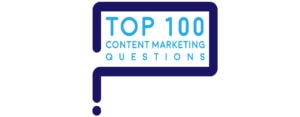
“How do we make a content plan that targets users’ interests (and keep it relevant)?”
A marketer at CarMax asked one of the Top 100 Questions on content marketing: “How do we make a content plan that targets users’ interests (and keep it relevant)?”
Editor’s Note: We’ve identified and answered marketers’ Top 100 Questions on content marketing since 2017. So far, 636 client-side marketers have asked 2100 questions in our workshops. Based on our latest AI-powered text analysis of marketers’ questions, today we begin to answer questions that are newly added to the Top 100.
Audiences, not editors, decide what’s relevant
I started my career in journalism, where I learned that: “News is whatever the editor says it is.” Indeed, our editor always made the final call on what was relevant and what would or would not appear in the news.
While editors once held sway, today people decide for themselves what’s relevant. That’s why I say:
“Content is whatever the audience says it is.”
Fortunately, most marketers have figured this out, as seen in the new 2020 research on content marketing.
Two new studies from the Content Marketing Institute and Marketing Profs show that most marketers put the needs of their audience first as they create content.
Specifically, marketers put audience needs ahead of the company’s need to deliver a sales message.
It’s smart to put your audience’s needs first
Why? Because the whole idea of content marketing is to attract and retain subscribers who may do business with you in the future.
Prospects and customers don’t subscribe to content that’s all about your brand. Instead, they want content that’s all about them.
New research from the Content Marketing Institute (CMI) and Marketing Profs shows that 3 out of 5 business to consumer (B2C) marketers prioritize their audience’s informational needs over sales and promotional messages.

Bravo!
The B2B study is even more revealing. It shows that, the more marketers prioritize audience needs, the more successful their content marketing is.

It pays to put your audience first with relevant content
- Overall, 2 out of 3 B2B marketers (66%) put audience needs first. But there’s a 38% gap on this question between the least successful and most successful marketers.
- Only half (50%) of the least successful B2B marketers put audience needs first.
- But 9 out of 10 (88%) of the most successful B2B marketers put audience needs first.
That one difference speaks volumes.
If you’re still putting sales and promotional content ahead of the informational content your audience needs, it’s time to change your approach.
Want to be a most successful marketer?
Here’s a clear path to become a most successful marketer. Take these steps:
- Use buyer persona research to find out what content your audience seeks out. The better you know your audience, the better you can create content they’ll crave.
- Write a content marketing mission that truly addresses your audience’s information needs. Here’s a template to help you.
- Build your content mission into your written content marketing strategy. Co-create your strategy with colleagues and internal clients, using our one-page content marketing strategy template.
- As a starting point, discover your customers’ top 100 questions – then turn them into compelling content.
- Build a content marketing editorial schedule to help you stay focused.

“How do we make a content plan that targets users’ interests (and keep it relevant)?” is one of marketers’ Top 100 Questions on Content Marketing. Here are the answers.





